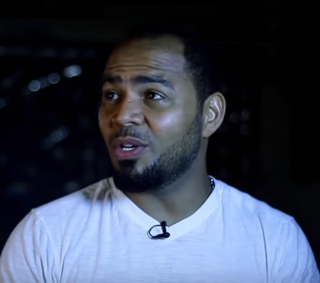The film industry or motion picture industry comprises the technological and commercial institutions of filmmaking, i.e., film production companies, film studios, cinematography, animation, film production, screenwriting, pre-production, post-production, film festivals, distribution, and actors. Though the expense involved in making films almost immediately led film production to concentrate under the auspices of standing production companies, advances in affordable filmmaking equipment, as well as an expansion of opportunities to acquire investment capital from outside the film industry itself, have allowed independent film production to evolve.

The cinema of Nigeria, often referred to informally as Nollywood, consists of films produced in Nigeria; its history dates back to as early as the late 19th century and into the colonial era in the early 20th century. The history and development of the Nigerian motion picture industry is sometimes generally classified in four main eras: the Colonial era, Golden Age era, Video film era and the emerging New Nigerian cinema era.

Ramsey Nouah is a Nigerian actor and director. He won the Africa Movie Academy Award for Best Actor in a Leading Role in 2010 for his performance in the movie The Figurine. He made his directorial debut with the film Living in Bondage: Breaking Free in 2019 and also went on to direct Nollywood classic Rattle Snake: The Ahanna Story which is a remake of Rattlesnake (1995).
Chico Ejiro was a Nigerian movie director, screenwriter, and producer. Little was known about Ejiro other than he was born in Isoko, Delta, Nigeria; he originally studied agriculture; and he was drawn into video production because Nigerians would not buy blank video cassettes. His enormous body of work was typical of the second generation that started in the 1990s when cheap video-production equipment became available in the country. He owned a production company called Grand Touch Pictures, which is based in Lagos.
Welcome to Nollywood is a 2007 documentary film about the Nigerian movie industry, directed by Jamie Meltzer. It premiered at the Full Frame Documentary Film Festival, and also played at the Avignon Film Festival and the Melbourne International Film Festival in the summer of 2007.

Kunle Afolayan is a Nigerian actor, producer and director. He is widely credited for elevating the quality of Nollywood movies through larger budgets, shooting on 35mm, releasing in cinemas, and improving cliché Nollywood storylines. After starting his film career as an actor in the 1999 political drama Saworoide, Afolayan made his directorial debut in 2006 with Irapada, a Nigerian supernatural thriller, which won the Africa Movie Academy Award for Best Film in an African Language. His follow-on directing credits include The Figurine, Phone Swap, October 1, and Citation. October 1 was the winner of 16 major African movie awards in 2015 and the second highest grossing Nigerian film at the time of its release, a feat Afolayan was to repeat two years later with The CEO. In 2021, the director signed a three-picture deal with Netflix. Swallow, the screen adaption of Sefi Atta's book of the same name was the first to be released in October 2021, followed by Aníkúlápó, an epic Nigerian fantasy released in September 2022. Afolayan has described the work as a "Game of Thrones recreated in Nigeria but with a better representation of our culture”. Eleven days after its release, it was the #1 most-watched non-English Netflix original film.

Living in Bondage is a 1992/93 Nigerian two-part drama thriller film directed by Chris Obi Rapu, written by Kenneth Nnebue and Okechukwu Ogunjiofor, produced by Ogunjiofor, and sponsored by Jafac Wine. The film was shot straight-to-video, and starred Kenneth Okonkwo and Nnenna Nwabueze in their breakout roles. It is regarded as the first Nigerian home video which achieved blockbuster success.

irokotv is a web platform that provides paid-for Nigerian films on-demand. It is one of Africa's first mainstream online movie streaming websites, providing access to over 5,000 Nollywood film titles. irokotv is a part of iROKO Limited, which is one of Africa's entertainment companies.

Amaka Igwe was a Nigerian filmmaker and broadcasting executive. Igwe was the owner of Top Radio 90.9 Lagos and Amaka Igwe Studios. She was recognized as one of the second-generation filmmakers who helped begin the video film era of Nigerian cinema. She remained a prominent figure in the industry until her death in 2014 resulting from an asthma attack.

Golden Age or Golden era are terms used in Nigerian film history to designate the motion picture industry of Nigeria from the late 1950s to the late 1980s. It captures the mode of visual and sound production, as well as the method of distribution employed during this period. This period began with the formal recognition of the Nigerian Film Unit as a sector in 1954, with the first film entirely copyrighted to this unit being Fincho (1957) by Sam Zebba.

New Nigerian Cinema or New Nigerian Cinema era is an emerging phase in Nigerian cinema, in which there became a major shift in the method of film production, from the video format, which came about during the video boom, back to the cinema method, which constituted the films produced in the Golden era of Nigerian cinema history. The films in the New Wave are specifically characterized by improved narrative complexity, aesthetic nuance, much higher budgets and advanced overall production values, when compared to video films from the second generation of filmmakers. They are mostly released theatrically, although some are still released directly on DVD.

Nollywood, a portmanteau of Nigeria and Hollywood, is a sobriquet that originally referred to the Nigerian film industry. The origin of the term dates back to the early 2000s, traced to an article in The New York Times. Due to the history of evolving meanings and contexts, there is no clear or agreed-upon definition for the term, which has made it a subject of several controversies.

Cinema of Ghana also known as the Ghana Film Industry nicknamed Ghallywood, began when early film making was first introduced to the British colony of Gold Coast in 1923. At the time only affluent people could see the films, especially the colonial master of Gold Coast. In the 1950s, film making in Ghana began to increase. Cinemas were the primary venue for watching films until home video became more popular. The movie industry has no official name as yet since consultations and engagements with stakeholders has been ongoing when a petition was sent to the Ministry of Tourism, Arts and Culture which suspended the use of the name Black Star Films.

Tope Oshin is a Nigerian television and film director, producer and casting director, listed as one of the most influential Nigerians in film in 2019. In 2015 Pulse magazine named her as one of "9 Nigerian female movie directors you should know" in the Nollywood film industry. and in March 2018, in commemoration of the Women's History Month, Tope was celebrated by OkayAfrica as one of the Okay100 Women. The interactive campaign celebrates extraordinary women from Africa and the diaspora making waves across a wide array of industries, while driving positive impact in their communities and the world at large.

Emem Isong is a Nigerian screenwriter, film producer, and film director. She has become known primarily for films in the English language, and is a dominant figure in the Nollywood industry. Her second directed feature, Code of Silence, which deals with rape in Nigeria, was released in 2015.

Living in Bondage: Breaking Free, also known as Living in Bondage II, is a 2019 Nigerian supernatural thriller executive produced by Charles Okpaleke. A sequel to the 1992 classic Living in Bondage, the film stars Kenneth Okonkwo, Kanayo O. Kanayo, Enyinna Nwigwe, and Muna Abii, with Swanky JKA in his breakout role, and Ramsey Nouah, who makes his directorial debut, playing the main villain. It received mostly positive reviews and ranked 11th overall on the list of highest-grossing Nigerian films of all time at the end of its theatrical run. The film premiered on Netflix in May 2020.
Charles Okpaleke, OON is a Nigerian film producer. His debut film, Living In Bondage: Breaking Free won seven awards at the Africa Magic Viewers’ Choice Awards 2020, including the Best Movie and Best Overall Movie categories. He has also acquired the rights to remake Nollywood classics including Rattle Snake, Nneka the Pretty Serpent and Glamour Girls.
Jennifer Okere was a Nigerian actress and one of the pioneers of the Nigerian film industry (Nollywood) in the 1990s. Her two ground-breaking Nollywood blockbuster movies, Living in Bondage and Glamour Girls have been re-adapted. She was the posthumous recipient, of the 2016 Afro Heritage Broadcasting and Entertainment Awards (AHBEA) in Houston, Texas.
Steve Gukas is a Nollywood filmmaker, director and producer who believes that films should be used to address the ills of the society.
Kenneth Nnebue is a Nigerian film producer and director known for pioneering the use of VHS in producing films. He produced and co-directed Nigeria's first feature film, Living in Bondage (1992). The film was shot straight-to-video, and starred Kenneth Okonkwo and Nnenna Nwabueze in their breakout roles. Nnebue had an excess number of imported video cassettes which he then used to shoot his first film on a Video camera. It is regarded as the first Nigerian home video which achieved blockbuster success. Nnebue had been producing Yoruba-language video films prior to Living in Bondage, with his first film being Aje Ni Iya Mi (1989), which was also very profitable.











